Contents
|
|
Introduction
A reporting group is a collection of accounts. The accounts are combined to facilitate group level reporting and group level performance calculations. A group is a separate entity, apart from the accounts it contains. You can put as many accounts and groups in a reporting group as you wish.
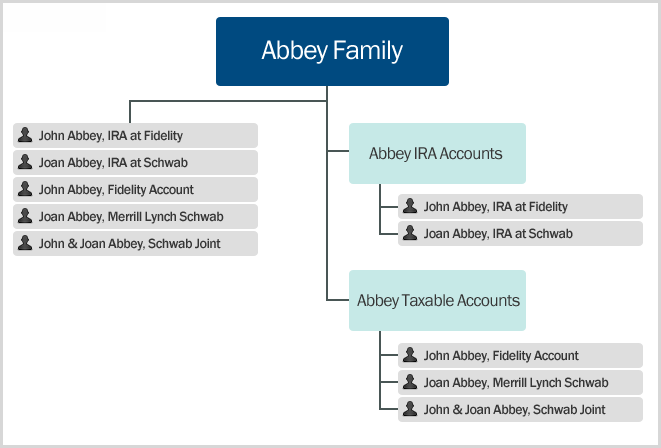
In the example above, you would want to use a reporting group in the following instances:
| For the Abbey IRA Accounts group | You want to print a Holdings report that includes positions from both accounts. |
| For the Abbey Taxable Accounts group | You want to calculate and present performance reports for the taxable accounts only, rather than presenting them for the entire group. |
Create a Reporting Group
To create a reporting group in Advisor View:
-
On the Accounts menu, click Accounts.
-
In the Actions list, click Create New Group.
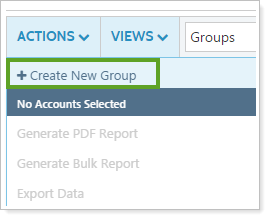
-
Complete the following panels (click the name of the page for details on the page and settings):
| Tab | Panel | Settings |
|---|---|---|
| Settings | Account Group | This panel allows you to configure the basic settings for the reporting group, such as the account type, closed date, and inception dates. It is available when you edit a reporting group on the Accounts page. |
| Name/Address | This panel allows you to configure the basic settings for the account, such as name and address. It is available under the Settings menu when you edit a reporting group on the Accounts page. | |
| Reporting | Settings/Templates | This panel allows you to determine reporting options such as fiscal year end dates, default templates, and sync start dates. It is available when you edit a reporting group on the Accounts page. |
| Benchmarks/Targets | This panel allows you to assign benchmarks and target allocations for the reporting group. It is available under the Reporting menu when you edit a reporting group on the Accounts page. | |
| Membership | Direct Members |
This panel contains a list of accounts and groups that are direct members of the selected reporting group. It is available under the Membership panel when you edit a reporting group on the Accounts page. |
| All Members | This panel lists all accounts included in the reporting group—both accounts that are direct members of the selected reporting group and indirect members (direct members of sub-reporting groups assigned to the reporting group). This read-only panel is available under the Membership menu when you edit a reporting group on the Accounts page, and you can use it to get a complete picture of all accounts assigned to the reporting group. | |
| Households/Groups |
This panel allows you to see the Households and reporting groups that the reporting group is a member of. This panel is available under the Membership menu when you edit a reporting group on the Accounts page. |
|
| Clients | This panel shows you the clients that can view the account information. Since clients are assigned at the Household level, you can easily audit access at the account level. If you need to make any changes, you can make them at the Household level since this is a read-only panel. It is available under the Membership menu when you edit a reporting group on the Accounts page. | |
| Custom Fields | N/A | This panel allows you to assign values to custom fields you've already created for reporting groups. It is available when you edit a reporting group on the Accounts page. For more information on custom fields, including creating the fields, visit Custom Fields for Accounts, Reporting Groups, Households, and Securities. |
| Service Team | N/A | This panel allows you to see the service teams that are assigned to the reporting group. It is available when you edit a reporting group on the Accounts page. |
| Advanced | Category Overrides | This panel allows you to rename any category or benchmark for any individual account or reporting group. Your changes will be shown only on that account or reporting group's reports. |
| Manual Performance | This panel allows you to edit how your manual performance will be shown if you uploaded manual performance and have editing permission. It is available under the Advanced menu when you edit a reporting group on the Accounts page. |
-
When finished, click Save.
Delete a Reporting Group
To delete a group:
-
On the Accounts menu, click Accounts.
-
Click the name of the group you want to delete. Reporting groups appear in a bold font.
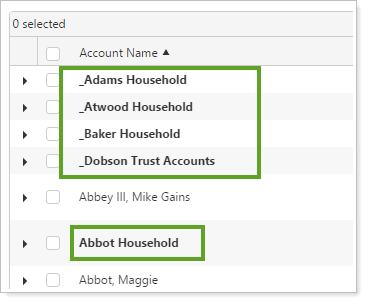
-
On the Edit Group dialog, click Delete in the lower-left corner.
Add an Account to a Group
You can add accounts to a reporting group in two places:
-
From the group's Direct Members panel.

-
From the account's Households/Groups panel.

Modify or Delete Multiple Groups At Once
To edit more than one group at the same time:
-
On the Accounts menu, click Accounts.
-
Select the check box next to the groups you want to edit.
-
In the Actions list, click Edit.
NOTE
Advisor View will show you the fields that you can edit via multi-edit. If a field does not appear, you'll need to make the changes one at a time for each group.
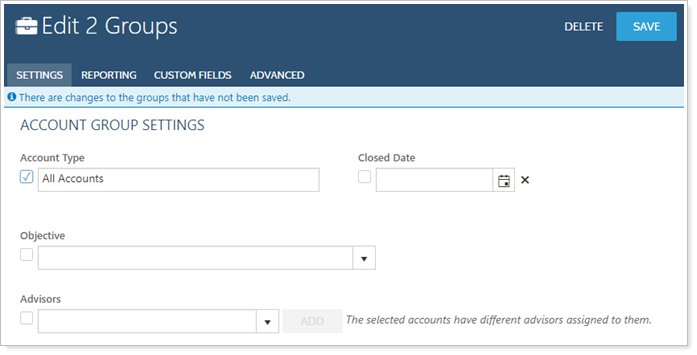
-
Select the check box next to the information you want to edit for all selected reporting groups. If you don't select a check box next to a setting, Advisor View will not change the values for that setting. To learn about all the settings that will appear, click a link below.
To delete the groups in bulk, click Delete. Then, in the Delete Group dialog, click Delete to confirm.
| Tab | Panel | Settings |
|---|---|---|
| Settings | Account Group | This panel allows you to configure the basic settings for the reporting group, such as the account type, closed date, and inception dates. It is available when you edit a reporting group on the Accounts page. |
| Name/Address | This panel allows you to configure the basic settings for the account, such as name and address. It is available under the Settings menu when you edit a reporting group on the Accounts page. | |
| Reporting | Settings/Templates | This panel allows you to determine reporting options such as fiscal year end dates, default templates, and sync start dates. It is available when you edit a reporting group on the Accounts page. |
| Benchmarks/Targets | This panel allows you to assign benchmarks and target allocations for the reporting group. It is available under the Reporting menu when you edit a reporting group on the Accounts page. | |
| Membership | Direct Members |
This panel contains a list of accounts and groups that are direct members of the selected reporting group. It is available under the Membership panel when you edit a reporting group on the Accounts page. |
| All Members | This panel lists all accounts included in the reporting group—both accounts that are direct members of the selected reporting group and indirect members (direct members of sub-reporting groups assigned to the reporting group). This read-only panel is available under the Membership menu when you edit a reporting group on the Accounts page, and you can use it to get a complete picture of all accounts assigned to the reporting group. | |
| Households/Groups |
This panel allows you to see the Households and reporting groups that the reporting group is a member of. This panel is available under the Membership menu when you edit a reporting group on the Accounts page. |
|
| Clients | This panel shows you the clients that can view the account information. Since clients are assigned at the Household level, you can easily audit access at the account level. If you need to make any changes, you can make them at the Household level since this is a read-only panel. It is available under the Membership menu when you edit a reporting group on the Accounts page. | |
| Custom Fields | N/A | This panel allows you to assign values to custom fields you've already created for reporting groups. It is available when you edit a reporting group on the Accounts page. For more information on custom fields, including creating the fields, visit Custom Fields for Accounts, Reporting Groups, Households, and Securities. |
| Service Team | N/A | This panel allows you to see the service teams that are assigned to the reporting group. It is available when you edit a reporting group on the Accounts page. |
| Advanced | Category Overrides | This panel allows you to rename any category or benchmark for any individual account or reporting group. Your changes will be shown only on that account or reporting group's reports. |
| Manual Performance | This panel allows you to edit how your manual performance will be shown if you uploaded manual performance and have editing permission. It is available under the Advanced menu when you edit a reporting group on the Accounts page. |
-
Click Save.
Modify a Single Reporting Group
-
On the Accounts menu, click Accounts.
-
Click the name of the group that you want to edit.
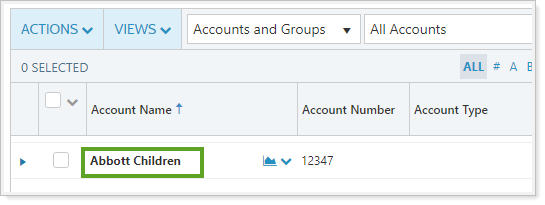
-
Complete the following information on the panel that appears (click the name of the page for details on the page and settings):
| Tab | Panel | Settings |
|---|---|---|
| Settings | Account Group | This panel allows you to configure the basic settings for the reporting group, such as the account type, closed date, and inception dates. It is available when you edit a reporting group on the Accounts page. |
| Name/Address | This panel allows you to configure the basic settings for the account, such as name and address. It is available under the Settings menu when you edit a reporting group on the Accounts page. | |
| Reporting | Settings/Templates | This panel allows you to determine reporting options such as fiscal year end dates, default templates, and sync start dates. It is available when you edit a reporting group on the Accounts page. |
| Benchmarks/Targets | This panel allows you to assign benchmarks and target allocations for the reporting group. It is available under the Reporting menu when you edit a reporting group on the Accounts page. | |
| Membership | Direct Members |
This panel contains a list of accounts and groups that are direct members of the selected reporting group. It is available under the Membership panel when you edit a reporting group on the Accounts page. |
| All Members | This panel lists all accounts included in the reporting group—both accounts that are direct members of the selected reporting group and indirect members (direct members of sub-reporting groups assigned to the reporting group). This read-only panel is available under the Membership menu when you edit a reporting group on the Accounts page, and you can use it to get a complete picture of all accounts assigned to the reporting group. | |
| Households/Groups |
This panel allows you to see the Households and reporting groups that the reporting group is a member of. This panel is available under the Membership menu when you edit a reporting group on the Accounts page. |
|
| Clients | This panel shows you the clients that can view the account information. Since clients are assigned at the Household level, you can easily audit access at the account level. If you need to make any changes, you can make them at the Household level since this is a read-only panel. It is available under the Membership menu when you edit a reporting group on the Accounts page. | |
| Custom Fields | N/A | This panel allows you to assign values to custom fields you've already created for reporting groups. It is available when you edit a reporting group on the Accounts page. For more information on custom fields, including creating the fields, visit Custom Fields for Accounts, Reporting Groups, Households, and Securities. |
| Service Team | N/A | This panel allows you to see the service teams that are assigned to the reporting group. It is available when you edit a reporting group on the Accounts page. |
| Advanced | Category Overrides | This panel allows you to rename any category or benchmark for any individual account or reporting group. Your changes will be shown only on that account or reporting group's reports. |
| Manual Performance | This panel allows you to edit how your manual performance will be shown if you uploaded manual performance and have editing permission. It is available under the Advanced menu when you edit a reporting group on the Accounts page. |
-
Click Save.
Reporting Group Notes
Notes in Advisor View allow you to add documentation to accounts that can be widely seen by other users who have permission to view those accounts. Client wishes, account changes, alerting to special circumstances and other issues, including compliance issues, can be documented in groups using notes.
To learn more about account notes, see Learn More About Notes.


